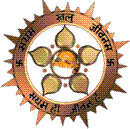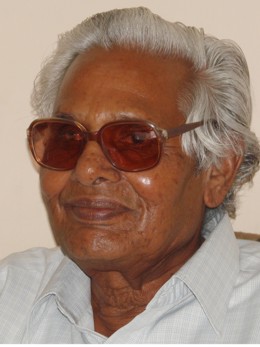
Finally an outline emerges and Acarya Sri launched the Anuvrata Movement in Sardarshahar on March 1, 1949. Earlier, nine-point and thirteen-point programmes had been propagated in an experimental manner.
These programmes had been adopted by some twenty-five thousand people. They could be regarded as a prelude to the Anuvrata Movement. The Movement was originally called Anuvrati Sangh (Anuvrata Association). It started with Acarya Sri's long marches. In the prevailing situation movements aimed at developing character greatly needed. Anuvrata Sangha or Anuvrata Association fulfilled a felt need and therefore it did not take long to become popular. The public welcomed it as a beacon. Hundreds of people would gather in small villages, hear the vows of the Movement and adopt them.
The Movement had already crossed the boundaries of India. At the time of the inaugural session newspapers in England and America had given beautiful coverage on it. The well-known New York Weekly Time in its edition of May 15, 1950 wrote under the caption "The Atomic Bomb". Like some people in other places a lean, short, bright - eyed Indian is extremely worried about the present world situation. He is thirty-four year old Acarya Tulasi who is the head of the Terapantha Sect of the Jains. It is a religious community, which believes in non-violence. Acarya Tulasi founded the Anuvrati Sangha in 1949. After he has won over the whole of India to his vows, he plans to do the same with the rest of the world.'
The Anuvrata attracted notice in Japan also. The reactions of the people of all these countries reached the Acarya. Briefly the feelings of those people were that the vows had been propounded keeping India in mind and that a number of them were not useful for them. Then the Acarya decided to effect changes in the outline of the vows. The changes were necessary if the Movement was to have a worldwide impact. They were motivated by the thought that since the basic nature of man is universally uniform, only vows in consonance with it may be widely propagated. Thus the number of basic vows went up to 42. According to the original outline there were no graded steps or stages for the followers of the Movement. Those who accepted the thirteen-point plan did not consider themselves members of the Movement. Then while there were some people who did not resort to malpractices like payoffs and income tax evasion, there were others who found themselves unable to avoid them. Under the circumstances it was felt that it would be good to lay down progressive stages for the anuvratis (followers of anuvrata). On the basis three classes of anuvratis were prescribed:
- New Entrant Anuvratis,
- Anuvratis,
- Advanced Anuvratis.
The vows prescribed for these classes were 11, 42 and 4 respectively.
Sarvodaya leader Acarya Vinoba Bhave criticised the atomic vow concerning truth. He felt that there can be an atomic vow of non-violence, but truth is indivisible and it therefore admits of only totality in the form of mahavrata (total allegiance to truth). Acarya Sri gave it a serious consideration but Vinoba's argument did not carry conviction with him. Truth is not different from non-violence. There can be no truth where there is violence. Both non-violence and truth are intrinsically indivisible. Height cannot be divided but it takes several steps to reach it and each step is different from the other. The anuvratas or atomic vows are graded steps to reach spiritual heights.
In some quarters there was a rumbling that the Anuvrata Movement does not go to the base. It merely skims the surface. Without solving the economic problem it is in vain to think of moral development. Acarya Sri did not term it a one-sided untruth but he did not subscribe to the view that people having no economic problems are necessarily moral. People have a very limited view of morality. Is the aggressive instinct not immoral? The Movement mainly aims at creating a climate of non-aggression, peaceful living and satisfaction with one's rightful share of things. Is this not something basic?
Some thinkers expressed the opinion that if individuals like Lord Mahavira, Lord Buddha and Mahatma Gandhi could not make the world moral, how could Acarya Sri do it? To this Acarya Sri replied, when do I say that I am going to make the whole world moral? Of course our efforts should be directed towards that goal. The torch of morality should never be allowed to go out. Our efforts may not succeed, but we will at least not be blamed for not making them.
The work relating to anuvrata made some headway. But a new confusion arose. Our own followers started saying, 'Acarya Sri no longer insists on the people becoming Jains. He has slackened the propagation of Terapantha - on the other hand some non-Jains started saying that Acarya Sri wanted to convert everyone to Jainism under the cover of anuvrata. If on one side there were these reactions, on the other quite a few people stressed the great need for the Movement. C. Rajgopalachari had written at the time of the first session of anuvrata. 'In my opinion this (Anuvrata Movement) is the first step in the direction of people's moral and cultural emancipation.'
While many Western celebrities like Bertrand Russel and Martin Luther King were organizing huge peace rallies exhorting the people to raise their voice against the senseless genocide caused by the nuclear holocaust in Hiroshima and Nagasaki by a strange coincidence, as it were, a relatively unknown religious preceptor of the East heading a Jaina sect, seated far away in a remote town of the Thara desert of Rajasthan, was engaged in an indentical mission, thought in a small way, of rousing the masses against violence and moral torpor. He heard the inner call that commanded him to throw off the yoke of sectarian dogmatism and launched a crusade against caste, untouchability, subjection of women and religious intolerance. His response to the call resulted in the birth of Anuvrata Movement. It was in this very way that Simon and Andrew responded when Jesus walking by the sea of Galilee called to them. The only difference was that the call, which Acarya Tulasi heard came from within, not unlike the one Saint Joan, had heard centuries before in France. But unlike as in her case the inner voice directed the Acarya to launch a movement for liberating the individual from a bigoted sectarian outlook, fanaticism and an unethical approach, thereby automatically ensuring the emancipation of mankind.
The root of the malady lies in the individual. The Acarya realized that society couldn’t be purged without an inner transformation of man. Instinctively motivated by the maxim:
In small proportion we just beauties see;
And in short measures, life may perfect be.
 Dr. Sohan Lal Gandhi
Dr. Sohan Lal Gandhi